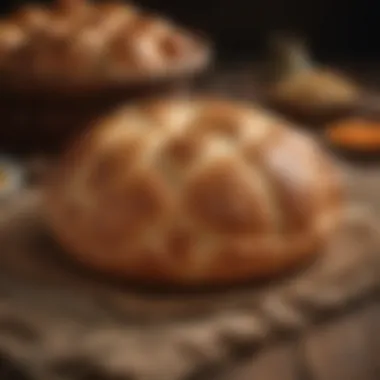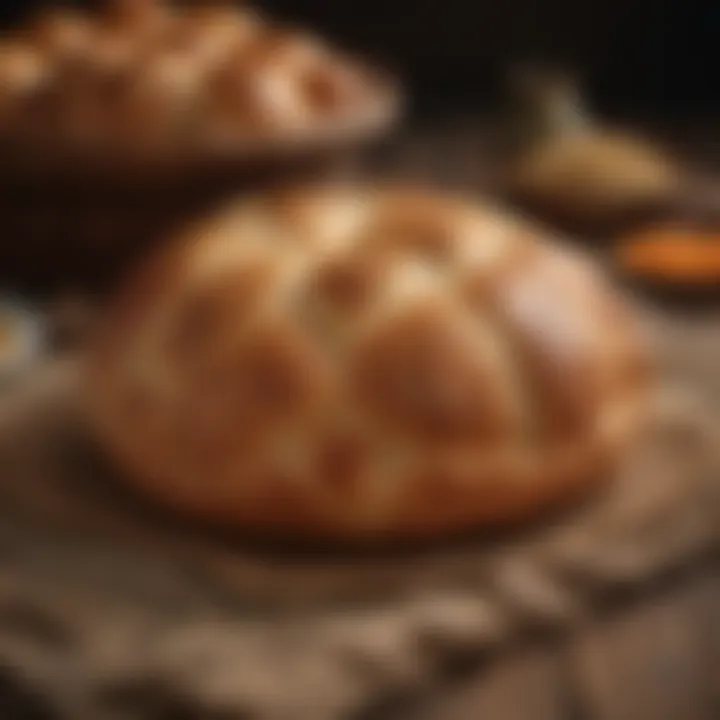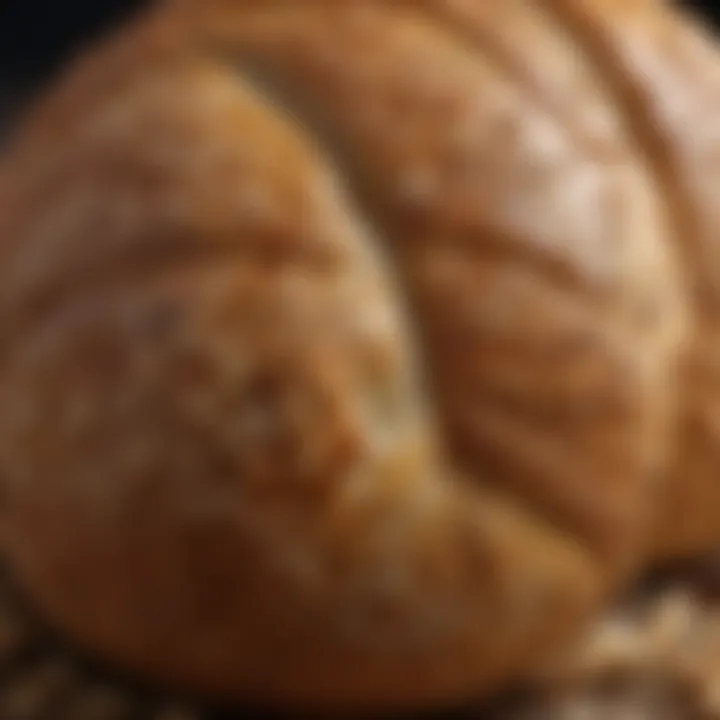Uzbek Bread: Recipes and Cultural Significance


Intro
Uzbek bread holds a significant place in the heart of Central Asian cuisine. It is not merely a food item; it serves as a cultural symbol and a culinary staple. The art of bread-making in Uzbekistan is steeped in tradition, showcasing a variety of recipes and techniques that have been passed down through generations. From daily meals to festive occasions, bread embodies the spirit of hospitality and community in Uzbek society.
In this article, we will delve into the various aspects of Uzbek bread, from its recipes to its cultural importance. We will examine the different types of bread, highlighting their unique preparation methods and the ingredients that define their flavor. Understanding these factors enhances one’s appreciation of this essential component of Uzbek life, appealing to culinary enthusiasts and culture lovers alike.
Prelims to Uzbek Bread
Uzbek bread occupies a central role in the culinary landscape of Uzbekistan. Its varied forms epitomize the nation’s rich cultural heritage and diverse culinary practices. Understanding the significance of Uzbek bread is essential for anyone interested in Central Asian cuisine. The history, recipes, and preparation methods are intertwined with the daily lives of the people.
This section aims to introduce the concept of Uzbek bread, emphasizing its culinary importance. It will explore how bread serves not only as a food item but also as a medium for cultural expression and social connection. Knowing more about Uzbek bread opens a window into the life and traditions of Uzbekistan.
Culinary Significance
The culinary significance of Uzbek bread is profound. For many families, bread is more than just a staple; it is a symbol of hospitality and warmth. In gatherings and meals, offering bread to guests is a demonstration of respect. Traditional Uzbek breads, such as Lepeshka or Non, are often served with various dishes, enhancing their flavor and providing a sense of completeness to the meal.
Moreover, the process of making bread is often a communal activity. Families come together to prepare and bake bread, passing down techniques and recipes through generations. This collaborative effort fosters a sense of unity while preserving tradition. The bread symbolizes life in Uzbekistan—it is present in celebrations, rituals, and family gatherings.
Historical Context
The historical context of Uzbek bread reveals its deep roots in the nation’s culture. Bread-making has been practiced for centuries in Uzbekistan, dating back to ancient civilizations. Various historical events, migrations, and cultural exchanges shaped the recipes and styles of bread unique to this part of Central Asia.
From the Silk Road traders to the agricultural influences from nearby regions, Uzbek bread reflects a melange of traditions and practices. The way bread is made and consumed tells the story of the Uzbek people’s resilience, resourcefulness, and their cherished way of life. As the country evolved, so did the techniques and types of bread, making it an ever-important culinary element that mirrors the landscape of (and changes in) society over time.
Types of Uzbek Bread
Understanding the various types of Uzbek bread is vital to appreciate the cultural and culinary landscape of Uzbekistan. Bread in this region is not merely food; it is a symbol of hospitality and sustenance. Each type has its unique characteristics and uses, reflecting the diverse traditions and lifestyles of the Uzbek people. This section will explore several types of bread, emphasizing their ingredients, preparation methods, and cultural significance, thereby enriching the reader's insight into a fundamental aspect of Uzbek life.
Lepeshka
Lepeshka is perhaps the most recognized type of Uzbek bread. This round, flat bread is traditionally baked in a tandoor, giving it a distinctive texture and flavor. The dough is often made with a simple mix of flour, water, yeast, and salt. Its preparation involves thorough kneading and fermentation, which contributes to its lightness.
The surface of a Lepeshka is usually adorned with a unique pattern, created by pressing with fingers or special tools before baking. This not only enhances its aesthetic but also allows for even cooking. Lepeshka is versatile; it can be served alongside soups, stews, or enjoyed with various meats and vegetables. Its presence at meals underscores its importance in Uzbek culture as a staple food.
Non
Non, another traditional bread variety, holds a similar place of esteem as Lepeshka. It varies significantly from region to region in Uzbekistan, which contributes to the diversity of flavors and textures. Non is thicker and often round but can also be flat. Depending on local customs, some types of Non include fillings such as pumpkin or nuts, enhancing its flavor.
Often, Non is baked in a clay oven, which imparts a smoky aroma, making it a preferred choice for accompanying special occasions or family gatherings. The bread is typically served warm, with the crust being crispy yet soft on the inside. Non symbolizes more than just food; it represents unity during communal meals, making it a significant component of Uzbek hospitality.
Other Regional Varieties
While Lepeshka and Non dominate the bread landscape, many other regional varieties showcase Uzbekistan's rich culinary diversity. For instance, Patir is a thicker bread, often seen in southern regions, characterized by a more robust texture. It's frequently used to accompany rich meats or savory stews.
Yarim is another interesting variety. It often integrates ingredients like herbs or spices into the dough, allowing for creative adaptations. Each region contributes to the bread-making tradition, with unique recipes passed down through generations. These varieties not only satisfy the palate but also serve as cultural artifacts that tell the story of Uzbekistan's history and social practices.
Key Ingredients and Their Role
In the art of making Uzbek bread, the selection and quality of ingredients play a pivotal role. Each component contributes to the final product's texture, flavor, and overall character. Understanding these ingredients is essential not just for creating authentic bread, but also for appreciating the cultural significance behind them.
Flour Types
Flour is the cornerstone of any bread recipe. In Uzbekistan, various types of flour are used depending on the specific bread. The most common flour is wheat flour, which is often classified by its protein content. Higher protein flours yield more gluten, creating a chewier texture that is desired in certain breads.
Different regions may produce specific types of wheat, adding unique flavors to the flour. For instance, some bakers might prefer white flour for its light texture, while others might opt for whole wheat flour for a heavier, denser loaf. The choice of flour directly impacts the bread's vertical rise and texture, thus influencing how well the bread pairs with traditional dishes.


Yeast and Leavening Agents
Yeast is essential for creating the lightness and airiness that good bread requires. In Uzbek baking, active dry yeast and fresh yeast are commonly used. The health of the yeast greatly affects the fermentation process and ultimately the rise of the bread. As yeast consumes sugars, it produces carbon dioxide, causing the dough to expand.
Other leavening agents may be used in specialty breads. Baking soda or baking powder can create lighter textures but are less common in traditional recipes. When selecting yeast, it is crucial to ensure its freshness and activity. A sluggish yeast will lead to dense, poorly risen bread, which detracts from the final product's quality.
Water and Salt Importance
Water serves as a solvent in bread-making, dissolving sugars and salts and activating proteins in the flour. The hydration level of the dough is critical; too much water can make the dough sticky, while too little can lead to a dry product. Soft water is often preferred in bread-making because it contains fewer minerals that can impede yeast activity.
Salt is another vital ingredient, often overlooked. It helps control fermentation and strengthens gluten structure. The quantity of salt can greatly influence flavor, acting as a flavor enhancer while also extending the bread's shelf life. However, careful measurement is necessary, as excessive salt can inhibit yeast activity.
"Water and salt provide not just taste, but also functionality in bread-making, ensuring a successful rise and flavor profile."
Traditional Preparation Techniques
Traditional preparation techniques hold great significance in the realm of Uzbek bread. Each step in the bread-making process contributes to the final product's texture, flavor, and cultural importance. Understanding these methods offers insight into the meticulous craft that has been passed down through generations. The authenticity of Uzbek bread relies heavily on these techniques, which serve as a connection to the past and a celebration of local culinary practices.
Mixing and Kneading the Dough
Mixing and kneading the dough is where the journey of Uzbek bread begins. The process requires careful attention to detail. Each ingredient, from flour to salt, needs to be combined in precise proportions.
Kneading, typically done by hand, is vital. This action develops gluten, giving the bread its characteristic chewiness. The dough must be worked until it becomes smooth and elastic. Many bakers reference the feel of the dough, relying on intuition rather than precise measurements. However, it is essential to maintain cleanliness during this stage to prevent contamination. A clean surface and clean hands ensure a good quality final product.
Here are key benefits of proper mixing and kneading:
- Texture Development: Good kneading creates the right structure for the bread.
- Flavor Enhancement: It allows ingredients to meld, enhancing the overall flavor.
- Fermentation Preparation: Properly mixed dough provides the ideal environment for fermentation.
Fermentation Process
Fermentation is a crucial phase in making bread, especially in Uzbek tradition. The dough is left to rise, allowing yeast to work its magic. During this process, fermentation transforms the simple mixture of ingredients into a fluffy and flavorful dough. The timing and temperature of fermentation are critical; both can influence the bread’s final texture and taste.
Factors to consider during fermentation include:
- Temperature Control: Warmer temperatures speed up fermentation; cooler ones slow it down.
- Time Management: Patience is essential as proper fermentation cannot be rushed. The dough usually needs at least an hour.
- Environmental Conditions: Humidity and altitude may also affect how the dough rises.
"Fermentation is often regarded as the secret behind the bread's texture and flavor; it allows the yeast to create carbon dioxide, which makes the dough rise."
Shaping the Bread
Shaping is the final step before baking in the traditional bread-making process. After fermentation, the dough is punched down, allowing excess gas to escape. Shaping requires skill, as the baker must carefully form the dough into the desired shapes, be it loaf, round or flat. Each shape has its purpose and affects how the bread bakes and tastes.
Several points to consider regarding shaping:
- Tension Creation: Proper shaping creates surface tension, which is important for a good rise in the oven.
- Aesthetic Appeal: Well-shaped bread adds to the cultural and visual significance; it showcases the baker's skill.
- Preparation for Baking: The final shape directly correlates with how the bread transfers heat in the oven, influencing the final texture and crust.
Baking Methods
Baking methods are a central aspect of Uzbek bread-making. They significantly influence the texture, flavor, and overall quality of the bread. Two primary methods are commonly used: tandoor baking and oven baking. Each method brings unique characteristics to the bread and showcases the rich traditions in Uzbek cuisine. Understanding these methods helps appreciate not just the science of baking but also the cultural practices surrounding these techniques.
Tandoor Baking
Tandoor baking is one of the oldest and most traditional methods used in Uzbekistan and the broader region. The tandoor is a cylindrical clay oven, which provides high temperatures essential for baking the bread quickly. This method creates a distinctive texture and flavor that can seldom be replicated with other baking techniques.
When the dough is shaped into round disks, it is pressed against the tandoor's walls, where it bakes rapidly. The direct heat contact ensures the outer surface crisps up, while the inside remains soft and chewy. This unique characteristic of tandoor-baked bread makes it a favorite in social gatherings and family meals.


Some of the advantages of using a tandoor include the following:
- Flavor: The smoky aroma from the clay oven enhances the taste of the bread.
- Temperature: The high heat results in a crisp crust, which many people find appealing.
- Cultural Significance: Tandoor baking is often done in communal settings, thus fostering social interactions and sharing.
Oven Baking
Oven baking is another method common in Uzbekistan, especially in urban areas. With the availability of modern gas or electric ovens, many bakers and home cooks prefer this method for its convenience and consistency. Oven baking allows for better control of temperature and baking time, which can yield consistent results.
In oven baking, bread is typically placed on baking trays or stones. The heat circulates uniformly, leading to even cooking. While oven-baked bread might lack the smoky flavor of tandoor-baked bread, various techniques can be used to enhance the overall taste. For instance, baking stones or steam techniques can help replicate some of the effects achieved in a tandoor.
Here are a few considerations regarding oven baking:
- Accessibility: It is often easier for people in urban settings to use an oven.
- Versatility: Many recipes can be adjusted to suit oven baking, allowing for creative variations of traditional breads.
- Consistency: Unlike tandoors that may require skill and experience, ovens can provide uniform results for all bakers.
Understanding both tandoor and oven baking methods offers insights into the adaptability of Uzbek cuisine, demonstrating how traditional practices evolve with time.
Modern Variations and Trends
The practice of bread making in Uzbekistan has evolved over time, influenced by globalization and dietary changes. These trends reflect not only a culinary shift but also an adaptation to contemporary lifestyles. Modern variations of Uzbek bread showcase creativity and personal expression while maintaining some ties to traditional methods. The exploration of these variations is essential, as it highlights the dynamic nature of Uzbek cuisine and its ability to incorporate new influences while remaining true to its roots.
Fusion Recipes
Fusion recipes have emerged as a prominent trend in the culinary world, combining traditional elements with global flavors. In Uzbekistan, bread making is not isolated from these influences. Rather, chefs and home cooks are experimenting by incorporating ingredients and techniques from diverse cuisines. For instance, one might find Uzbek bread filled with elements from Middle Eastern ingredients such as za'atar or spices from South Asia like turmeric or chili. This melding enriches the flavor profiles and appeals to a broader audience.
These innovative recipes often use traditional bread types as a base—like lepeshka or non—and elevate them with non-traditional toppings or fillings. Cooks may also blend local grains such as wheat with quinoa or other superfoods to enhance nutritional value. The allure of fusion recipes lies in their capacity to bring people together, encouraging sharing and experimentation in the kitchen.
Healthier Alternatives
As awareness of dietary health increases, many are seeking healthier alternatives to traditional bread. In Uzbekistan, there is a growing trend towards using whole grain flours, which are richer in nutrients compared to refined flours commonly used in classic recipes. Whole wheat, barley, and even rye are being explored to leverage their health benefits.
Additionally, gluten-free options are gaining traction. Cooked from different grains such as millet, rice, or chickpeas, these breads ensure that those with gluten sensitivities can still enjoy the ubiquitous presence of bread in Uzbek meals.
The quest for healthier versions of Uzbek bread does not diminish the traditional flavors; instead, it reflects a balanced approach to nourishment without compromising on taste. Local bakers and home cooks experiment with natural sweeteners, oils, and seeds to enhance flavor while reducing unhealthy ingredients.
The evolution of bread in Uzbekistan is a testament to its cultural resilience and adaptability, reflecting the society's ongoing relationship with food and health.
These modern variations and trends demonstrate that the world of Uzbek bread is vibrant and diverse, filled with creativity that respects its origins while embracing future possibilities.
Culinary Pairings
Culinary pairings play a significant role in enhancing the enjoyment and experience of meals, especially when it comes to Uzbek bread. This bread is not just a staple, but a vehicle for flavors, textures, and traditions that resonate through Uzbek culture. Understanding how to pair breads with various accompaniments can elevate a simple dish to a memorable feast. The right pairings highlight the unique characteristics of each type of bread while also complementing the main dishes served alongside.
When considering culinary pairings, several factors come into play. The first is the flavor profile of the bread itself. For instance, Lepeshka, a round flatbread with a crisp crust, offers a mild taste that works well with rich and spicy foods. The texture of the bread also matters; softer breads can absorb sauces better and serve as a comforting element to a dish. These elements must be taken into account to create a harmonious balance on the plate.
Accompaniments to Uzbek Bread
Uzbek bread is often served with a variety of accompaniments that enhance its flavor and cultural significance. Some common options include:
- Cheese: Salty varieties like Feta or local Qurut add a creamy contrast to the bread's texture.
- Butter: A pat of fresh butter on warm bread is a simple yet effective addition.
- Sour Cream: This adds a tangy richness that complements the mild flavor of the bread.
- Pickles: Various pickled vegetables provide a crunchy, acidic counterbalance.
- Herbs and Spices: Chopped cilantro or a sprinkle of cumin can enhance the overall experience.
Each accompaniment not only adds flavor but also reflects the Uzbek tradition of sharing meals, where bread is central to the gathering.
Pairing with Traditional Dishes
When it comes to pairing Uzbek bread with traditional dishes, there are numerous delightful combinations. These pairings allow the bread to shine while supporting the flavors of the main dishes. Here are some notable partnerships:


- Pilaf (Plov): A classic Uzbek dish, pilaf is often accompanied by non or Lepeshka. The bread soaks up the rich flavors of the rice and meat, creating a fulfilling meal.
- Shashlik (Grilled Meat Skewers): The smoky, savory taste of shashlik is perfectly complemented by warm bread, which serves to balance the bold flavors.
- Lagman (Noodle Soup): The hearty broth of lagman is enhanced by bread as it helps to soak up the juicy liquid.
Each of these pairings not only satisfies the palate but also cultivates a sense of community during meals. Bread in Uzbekistan is more than just food; it symbolizes sharing, warmth, and connection.
Cultural Importance of Bread in Uzbekistan
Bread holds a profound cultural significance in Uzbekistan, transcending its basic role as a staple food. It is considered a vital element that unites families, marks important occasions, and reflects the values and traditions of Uzbek society. Understanding this cultural role provides insights into the daily lives of the Uzbek people and their relationship with food.
Bread as a Symbol
In Uzbekistan, bread symbolizes prosperity and sustenance. It is customary to treat bread with respect; dropping a piece of bread is seen as a disrespectful act. The phrase "Bread is the source of life" resonates deeply within the culture, implying that the well-being of a family is intrinsically linked to the bread on their table. This reverence is manifested in various ways, including the way bread is served at meals and its role in hospitality.
Bread is often adorned with decorative markings, and specific types of bread are baked for different occasions, such as weddings or religious holidays. For instance, non, a traditional Uzbek flatbread, is not only a daily food but also a symbol of honor and generosity when served to guests. According to local customs, offering fresh, warm bread to visitors is a sign of warmth and acceptance, representing the host's goodwill.
Traditions Surrounding Bread
Various traditions related to bread underscore its significance in Uzbek culture. One such tradition is the offering of bread as a gesture of friendship. When a guest arrives, it is common to present them with a piece of bread alongside traditional dishes. This act reinforces social ties and shows appreciation for the guest's presence.
Moreover, rituals often include breaking bread during family gatherings. This practice is significant, as it strengthens bonds among family members and creates a sense of unity.
Another interesting aspect is the role bread plays during important festivals and holidays. For example, during Nauryz, a celebration of the spring equinox, special types of bread are prepared, symbolizing renewal and abundance. These traditions emphasize not only the culinary importance of bread but also its role in communal identity and continuity.
In summary, bread in Uzbekistan is much more than a food item; it is a vessel of cultural expression, a conduit of hospitality, and a critical component of the social fabric. Understanding the cultural importance of bread deepens appreciation for Uzbek traditions and enhances one's culinary experiences.
Tips for Making Uzbek Bread at Home
Making Uzbek bread at home is a rewarding endeavor for many cooking enthusiasts. It allows you to appreciate not only the flavors but also the cultural heritage embedded in these recipes. Understanding the details behind making this bread enhances the cooking experience and helps create authentic results.
Essential Equipment
Having the right equipment is fundamental when making Uzbek bread. Here are some key tools that can help simplify the process and improve the quality of your bread:
- Large Mixing Bowl: This is necessary for mixing dough ingredients thoroughly.
- Dough Scraper: A helpful tool for kneading dough and keeping work surfaces tidy.
- Rolling Pin: Useful for shaping the dough into the desired forms.
- Tandoor or Conventional Oven: While a tandoor provides the traditional taste, an oven can work just as well.
- Baking Stone: If using an oven, a baking stone can simulate the effects of a tandoor.
- Lid or Cloth: For covering the dough during fermentation to prevent it from drying out.
These tools together create an ideal atmosphere for cooking and allow for a more consistent product.
Common Mistakes to Avoid
When making Uzbek bread, it is easy to stumble into common pitfalls. Avoiding these mistakes will lead to better results:
- Skipping the Fermentation: A common error is not allowing the dough to rise sufficiently. This step is crucial as it develops flavor and texture.
- Incorrect Measurements: Precision is important in baking. Always measure ingredients accurately to avoid unbalanced dough mixtures.
- Ignoring Dough Texture: The dough should be soft but not sticky. Too much flour or water can affect the final quality.
- Not Preheating the Equipment: If using an oven or tandoor, make sure to preheat adequately for optimal baking results.
- Neglecting to Cover the Dough: Leaving the dough uncovered can lead to a dry crust, affecting the texture and final product taste.
By paying attention to these aspects, home bakers can elevate their bread-making skills and create an authentic taste reminiscent of Uzbek traditions.
"Bread is the staff of life and reflects the culture and values of the people who make it."
These tips aim to encourage a solid foundation for individuals interested in making Uzbek bread at home. With reflexive practice and a focus on detail, anyone can succeed in bringing this traditional bread into their kitchen.
Closure: The Enduring Legacy of Uzbek Bread
The concluding section addresses the lasting significance of Uzbek bread within both culinary and cultural frameworks. It encapsulates the multifaceted role bread plays in not just food preparation but also in the social structures and traditions of Uzbekistan. This is vital as it reflects broader cultural identity, unity, and heritage.
Uzbek bread is much more than a staple; it represents a culinary emblem deeply embedded in the nation’s heritage. Each loaf carries with it stories, traditions, and the communal spirit of the Uzbek people. The age-old techniques used in making bread speak to a dedication to craft, passed down through generations. This aspect itself highlights the continuity and evolution of cultural practices, making the study of Uzbek bread essential for a comprehensive understanding of Central Asian society.
Additionally, the significance of bread in Uzbek households underscores its position as a centerpiece during gatherings and celebrations. It is more than nourishment; it serves as a symbol of hospitality and abundance.
"Bread is the staff of life," alluding to its fundamental role in sustaining not just the body but also cultural connections.
As global culinary trends continue to evolve, the authentic traditions associated with Uzbek bread also adapt, blending modern elements with cherished practices. Awareness and appreciation of these evolving practices contribute to preserving culinary diversity and cultural identity.
In summary, the legacy of Uzbek bread extends beyond its ingredients and recipes. It encourages exploration of the historical, social, and cultural narratives that shape the identity of Uzbekistan. The journey through Uzbek bread invites individuals to appreciate and honor these time-tested traditions, ensuring they do not fade into obscurity.







